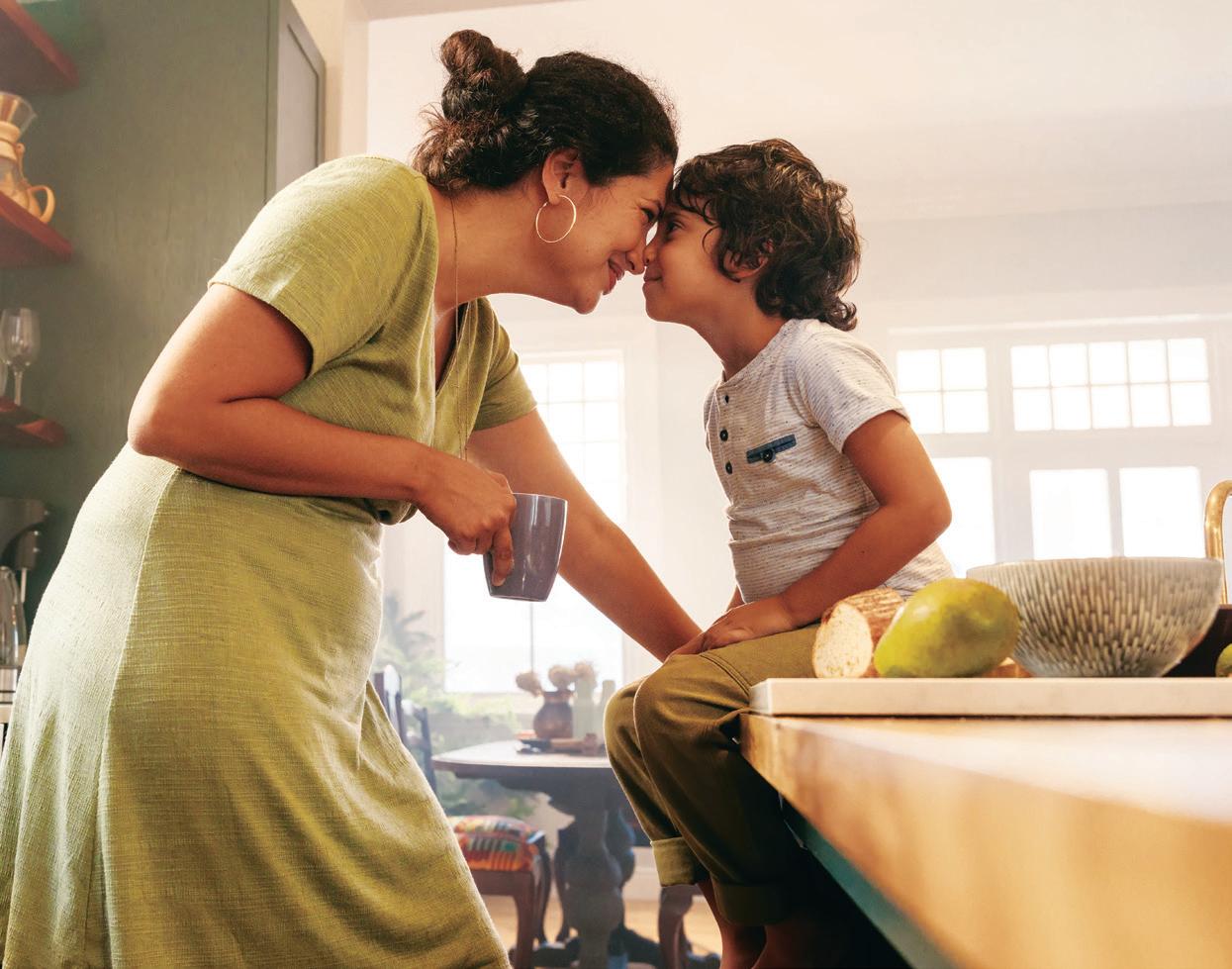

Rental Affordability
2024 SNAPSHOT
ANGLICARE VICTORIA - VICTORIAN RENTAL MARKET


Anglicare Victoria
Our Research
Anglicare Victoria’s 2024 Rental Affordability Snapshot (RAS) was conducted as part of the national snapshot undertaken by Anglicare Australia. The RAS is an annual survey of the affordability of rental properties for Victorians living on low incomes, such as those receiving Commonwealth income support payments or earning the minimum wage. It is also an opportunity for us to highlight the challenges they faced in the rental market and make a case for change. These individuals and families make up much of Anglicare Victoria’s client base, and the RAS shows just how hard it is for many of them to find a safe and affordable place to live.
The results of the 2024 RAS show the most vulnerable in our society continue to be left behind. Finding a suitable and affordable rental remains out of reach for students, job seekers, and those living with a disability. Median rents have increased substantially and at the same time, the cost of essential goods and services has skyrocketed, meaning many singles, couples and families are forced to make impossible choices to keep a roof over their heads. Affordability and availability has improved in some regional areas for some household types but worsened in Melbourne.
The 2024 Victorian RAS examined 12,845 rental listings advertised on Saturday 16 March 2024 across 32 local government areas (LGAs) in metropolitan Melbourne and 48 LGAs in regional Victoria.This data was used to calculate the proportion of these listings that would be both appropriate and affordable for 14 different household types including individuals, couples and families living on the minimum wage or a Commonwealth income support payment or pension. To be considered suitable and affordable, properties must be priced at less than 30 per cent of a household’s total income and have enough bedrooms to avoid overcrowding.
Further details about the methodology and data are available in the Data and Methodology section at the end of this report.
What we found
• Families without paid work are facing a dire situation. Across the state, 176 (1.4 per cent) out of 12,845 individual properties were suitable for at least one household type living on income support payments, a slight increase from 100 properties (0.9 per cent) in 2023.
• Lower chances for low-income workers. 2778 (21.6 per cent) of listings were suitable for at least one household type living on minimum wage without placing them in housing stress. This figure was 2998 (25.7 per cent) in 2023.
• Affordability has declined in metro Melbourne. While there has been a slight increase in the total number of rental properties available, only 28 out of 10,069 properties in metro Melbourne were affordable for Victorians on income support, and 1445 were affordable for those on minimum wage. This is a decrease from 58 and 2055 properties respectively in 2023.
• Country living offers more options. In regional Victoria 1333 out of 2776 properties were affordable for Victorians earning the minimum wage, and 148 affordable for those on income support, up from 943 and 42 respectively from 2023.
• Median weekly rents have risen sharply. In metropolitan Melbourne median rent increased by 14.3 per cent, and regional Victoria recorded an almost 7 per cent increase.
• Private rentals dry up for the most vulnerable. There were no properties that met the affordability criteria for singles on Youth Allowance or JobSeeker, and just one one property in the entire state which was affordable for someone reliant on the Disability Support Pension.
Victoria is growing faster than any other state. With demand already outstripping supply, the resulting squeeze will push rents higher.
• Rising house prices are adding pressure to the rental market. As property prices increase faster than household incomes, Victorians on income support and minimum wage are competing with higher-income professionals for the rental properties that are available.
What we can do
Australia needs a national strategy to end youth homelessness, particularly for those leaving state care. Only 2.9 per cent of social housing is leased to people under 24, even though young people aged 12 to 24 make up around a quarter of homeless people. A dedicated housing strategy aimed at addressing and preventing youth homelessness is needed, with a focus on the unique needs and risks faced by young people who are homeless, particularly those who have spent time in out-of-home care.
Victorians need more social and affordable housing. While the Victorian Government's welcome commitment to its Big Build project is welcome, the worsening private rental market has underlined the need for better collaboration between state and federal governments. Rising house prices and a fastgrowing population have combined to put further pressure on an already-undersupplied rental market.
Income support payments must be increased substantially to lift vulnerable Australians out of poverty. The low rates of Commonwealth support payments mean people are trapped in poverty and housing stress. Several years of cost-of-living increases mean people relying, people relying on payments such as JobSeeker, Youth Allowance and the Parenting Payment are forced to make impossible choices to keep a roof over their heads.
Commonwealth Rent Assistance must be urgently reformed to reflect current median rents. Doing so would allow those in housing stress to spend more of their money on healthy food, education, and transport. Continuing to index this payment every six months to the CPI is not enough.
We need a plan that tackles the causes of homelessness. More investment is needed in services to address family violence, substance abuse, mental health, and disability, which can push people into financial stress and homelessness. Women over 65 are the fastest-growing cohort of homeless people in Australia, due to lower wealth accumulation and relationship breakdown. More needs to be done to ensure that these women enjoy a safe and affordable home in their retirement.
More in-depth discussion of these recommendations can be found in the Policy Solutions section.
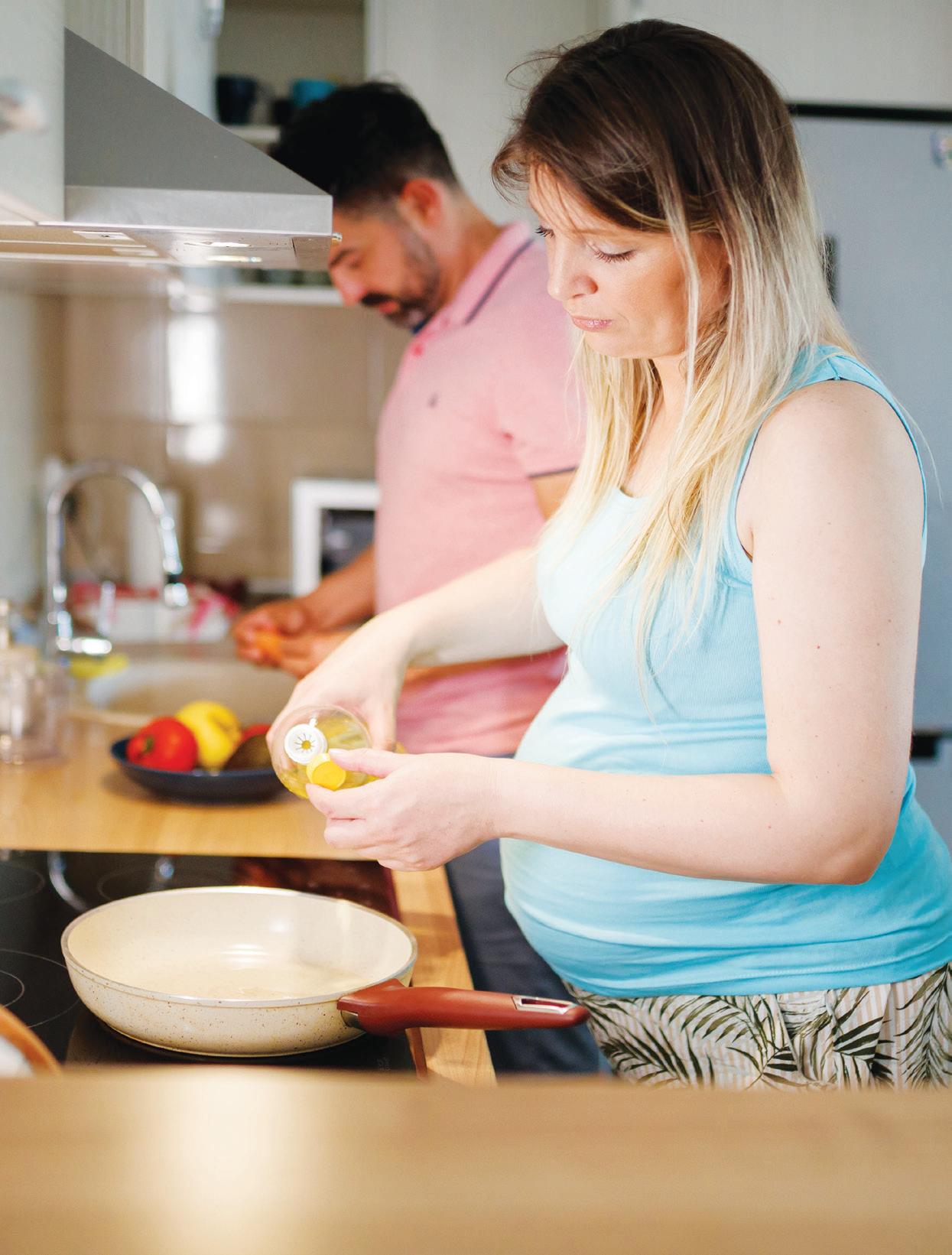
Key Findings
As in previous years, the data from the 2024 RAS has revealed the extent to which private rentals are out of reach for Victorians on income support and low wages, particularly job seekers, students and those living with a disability. Rent continues to stretch the household budgets of families and individuals, at a time when prices of other household essentials such as groceries, utilities and petrol are also rising.
While there has been an increase in the total number of properties available for rent, affordability continues to be an issue in metropolitan Melbourne.
Of the 12,845 private rentals available across Victoria:
• Just 1.4 per cent (176 properties) were suitable for households living on income support payments
• Around one fifth (2778) were suitable for households living on the minimum wage
Only 2778 (21.6 per cent) of the advertised properties were suitable for at least one household type living on minimum wage without placing them in housing stress. This figure is significantly lower than the 25.65 per cent that were affordable for these households in 2023, suggesting the minimum wage is not keeping up with rent increases.
For those on income support, 176 (1.4 per cent) were suitable for at least one household type living on government support payments, a minor improvement on the 100 properties (0.9 per cent) affordable that were affordable in 2023 – but to be clear, the situation remains bleak.
All the LGAs in metropolitan Melbourne had rental vacancy listings on realestate.com.au on the Snapshot day. Three of the 48 LGAs in regional Victoria did not have any properties listed on the day.
The headline trends noted in 2024 are as follows:
Families without paid work are facing a dire situation. An out-of-work couple with two children can afford only 0.3 per cent of rentals in Victoria. This equates to 40 properties out of the 12,845 available on the rental market. An out-of-work single parent with two children faces even tougher odds, with only eight properties affordable across the state. This helps explain why the rate of JobSeeker is such a critical factor in child poverty – one in six Victorian children lives in poverty, with those growing up in households that depend on JobSeeker at much greater risk.
Low-income workers are struggling more than last year. For households on minimum wage, affordability across the state has dropped to 21.63 per cent (2778 properties) in 2024, compared to 25.65 per cent (2998 properties) in 2023. In metropolitan Melbourne, 1455 (14.5 per cent) out of 10,069 individual properties were suitable for at least one household type living on minimum wage without placing them in housing stress. This figure was 20.9 per cent in 2023.
Affordability has declined in metro Melbourne for people on income support, with just 28 affordable properties across the city. However, this year’s Snapshot shows a notable increase in affordability for households on income support in regional areas, increasing from 42 properties in 2023 to 148 properties in 2024.
Median weekly rent has risen sharply in both metro and regional areas. There is an overall increase of 10 per cent from the 2023 Snapshot figures.
In metropolitan Melbourne median rent increased by 14.3 per cent, and regional Victoria recorded an almost 7 per cent increase. At the time of this Snapshot the median rent in Melbourne was $600 per week, and in regional Victoria it was $460 per week.
The most vulnerable in our community are being left behind. There were no properties in the state that met the affordability criteria for single people receiving Youth Allowance or JobSeeker payments, or single parents with one child. There was just one property in the entire state which was affordable for someone reliant on the Disability Support Pension, in a small town in regional Victoria.
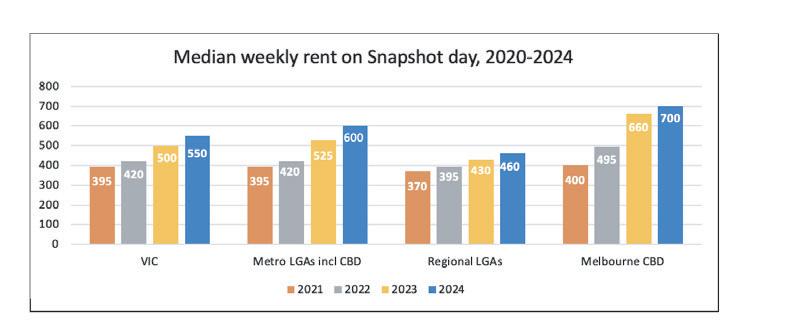
Our population is growing – fast. Data from the ABS revealed that Victoria’s population grew by 192,700 in the year to September 2023, more than any other state. This represents a growth rate of 2.5 per cent, which is the fastest pace of annual population growth since 1981. New migrants tend to rent for several years before buying a home, so for Victorians on low incomes this means increased competition for rental properties. With demand outstripping supply it is likely that median rents will continue to rise.
Rising house prices are adding pressure to the rental market. As property prices increase faster than household incomes, potential buyers are needing to save for longer for a home deposit. Higher interest rates are also lowering people’s borrowing power, constraining their ability to purchase a home. This means Victorians on income support and minimum wage are now competing with higher-income professionals for the rental properties that are available.
Figure 1: Median weekly rent on Snapshot day, 2020-2024, Victoria
Table 1: Total number of rental listings on Snapshot day, 2020-2024
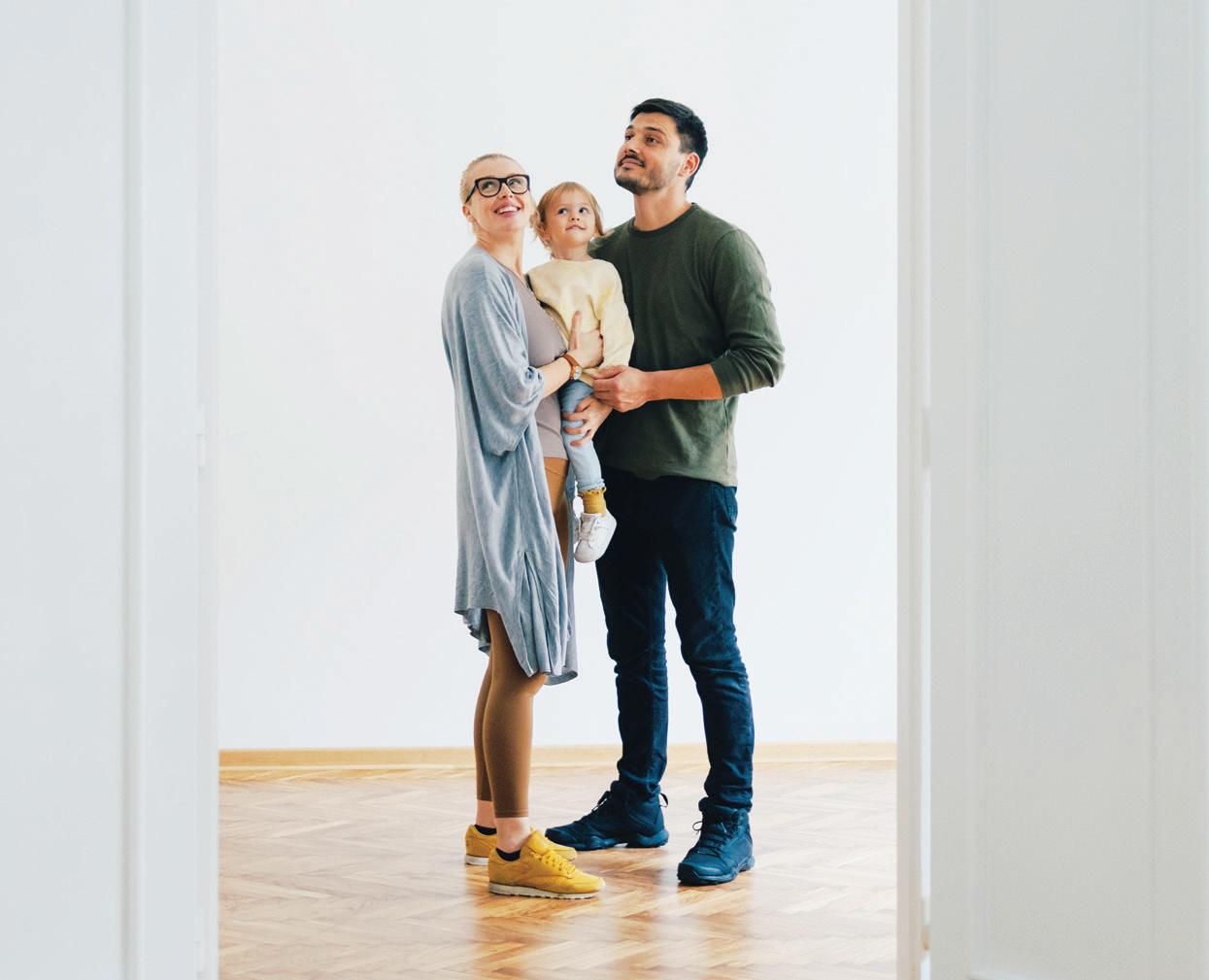
Rental Affordability, Victoria
On the Snapshot weekend of 16 March 2024, these are the number of unique properties affordable and appropriate for:
Households on income support payments (#1-10)
176
Households on minimum wage (#11-14) 2778
Couple, two children (one aged less than 5, one aged less than 10)
Single, two children (one aged less than 5, one aged less than 10)
Couple, no children
Single, one child (aged less than 5)
Single, one child (aged over 14)
Single
Single, over 21
Single
Single, over 18
Single in share house
Couple, two children (one aged less than 5, one aged less than 10)
Single, two children (one aged less than 5, one aged less than 10)
JobSeeker Payment (both adults) Parenting Payment (Single)
5,
than 10)
Parenting Payment (Single)
JobSeeker Payment Age Pension Disability Support Pension
JobSeeker Payment
Youth Allowance
Youth Allowance
Minimum wage + FTB A (both adults)
Minimum wage + FTB A and B + Parenting Payment (Single)
Minimum wage Minimum wage + Parenting Payment (Partnered) + FTB A and B
Metropolitan Melbourne
Across metropolitan Melbourne’s 32 LGAs there were 10,069 advertised rentals on the day the Snapshot was taken. This is an increase from the 9852 properties available in 2023.
Of these listings:
• 28 properties (0.3 per cent) were suitable for at least one household type living on income support without placing them in housing stress.
• 1455 properties (14.5 per cent) were suitable for at least one household type living on minimum wage without placing them in housing stress.
Fewer properties are affordable for Melburnians on low incomes
While the number of properties available for rent in metropolitan Melbourne has risen from 9852 in 2023 to 10,069 this year, the number of affordable properties for households reliant on income support has more than halved, dropping from 58 to just 28. This figure represents just 0.3 per cent of all properties advertised for rent on the Snapshot weekend.
Melburnians earning the minimum wage have more options, with 1455 properties (14.5 per cent) deemed affordable and appropriate. However, this is significant drop from the 2055 affordable properties (20.9 per cent) available in 2023.
At the same time, median weekly rents in Melbourne have risen steeply from $526 in March 2023 to $600. Not only are properties harder to find, but they are also becoming increasingly expensive.
Single parents are being priced out of the market
Whether earning minimum wage or receiving the Parenting Payment (Single), single parents living in Melbourne are being priced out to the rental market. A single parent with two children earning the minimum wage would be able to afford just 41 of the 10,069 properties available in metro Melbourne on the Snapshot weekend without going into rental stress.
For a single parent with two children relying on the Parenting Payment, just one property was deemed affordable and appropriate. This property was a three-bedroom home in Hoppers Crossing, priced at $495 per week with a bond of $2151. For single parents with one child receiving either Parenting Payment or JobSeeker, not a single property was affordable across the city.
Affordability for couples has also plummeted
In 2023, a family with both parents earning minimum wage could afford 2016 (20.46 per cent) of the advertised properties, or 300 (3.05 per cent) if one parent was employed and the other received the Parenting Payment. This year, these figures are 1423 (14.1 per cent) and 93 (0.9 per cent) respectively. This means that low income couples have fewer options when it comes to securing a rental for their family.
Students, job seekers, older Melburnians and those living with disabilities are being left behind
On the Snapshot weekend there were no properties available which met the affordability criteria for a single person receiving Youth Allowance, JobSeeker or the Disability Support Pension. 21 properties (0.2 per cent) were affordable for a couple on the Age Pension, and just 5 were suitable for a single Age Pension recipient, down from 28 in 2023. These people may be forced to live in unsuitable properties, share with others, or go without essentials like food and medication in order to afford a roof over their head.
The eastern suburbs are undersupplied and overpriced
Data from PropTrack has revealed that the eastern suburbs of Melbourne, which includes the LGAs of Whitehorse, Knox, Yarra Ranges, Maroondah and Manningham, had a rental vacancy rate of just 0.48 per cent in March 2024. This is reflected in the data obtained on the Snapshot weekend. There were just two properties in Whitehorse and six in Manningham which met our affordability criteria for Melburnians on income support. No eastern Melbourne LGAs made the Top 10 list for most affordable areas for those earning minimum wage.
Outer suburbs are more affordable than the CBD and inner city
Frankston, Brimbank and Monash were the most affordable LGAs for those receiving income support, while Melton, Brimbank and Whittlesea had the highest numbers of affordable properties for those on the minimum wage. However, the low number of properties on the market in each of these areas means renters are competing with many other families for available homes.
On the Snapshot weekend there were 5 properties available in Frankston, 4 in Brimbank and 3 in Monash that would be affordable for a person on income support. Melburnians employed in minimum-wage roles could afford 539 properties in Melton, 62 in Grangefields and 174 in Whittlesea. While there are more properties available for those on the minimum wage these figures represent a significant decline over the past two years. In the 2022 RAS there were 631 affordable properties in Melton and 375 in Whittlesea. The CBD area remains unaffordable for people on low incomes, with a median rent of $700 per week compared to the metro average of $600 per week.
Just 28 properties (0.3 per cent) in metropolitan Melbourne are affordable for someone relying on income support.
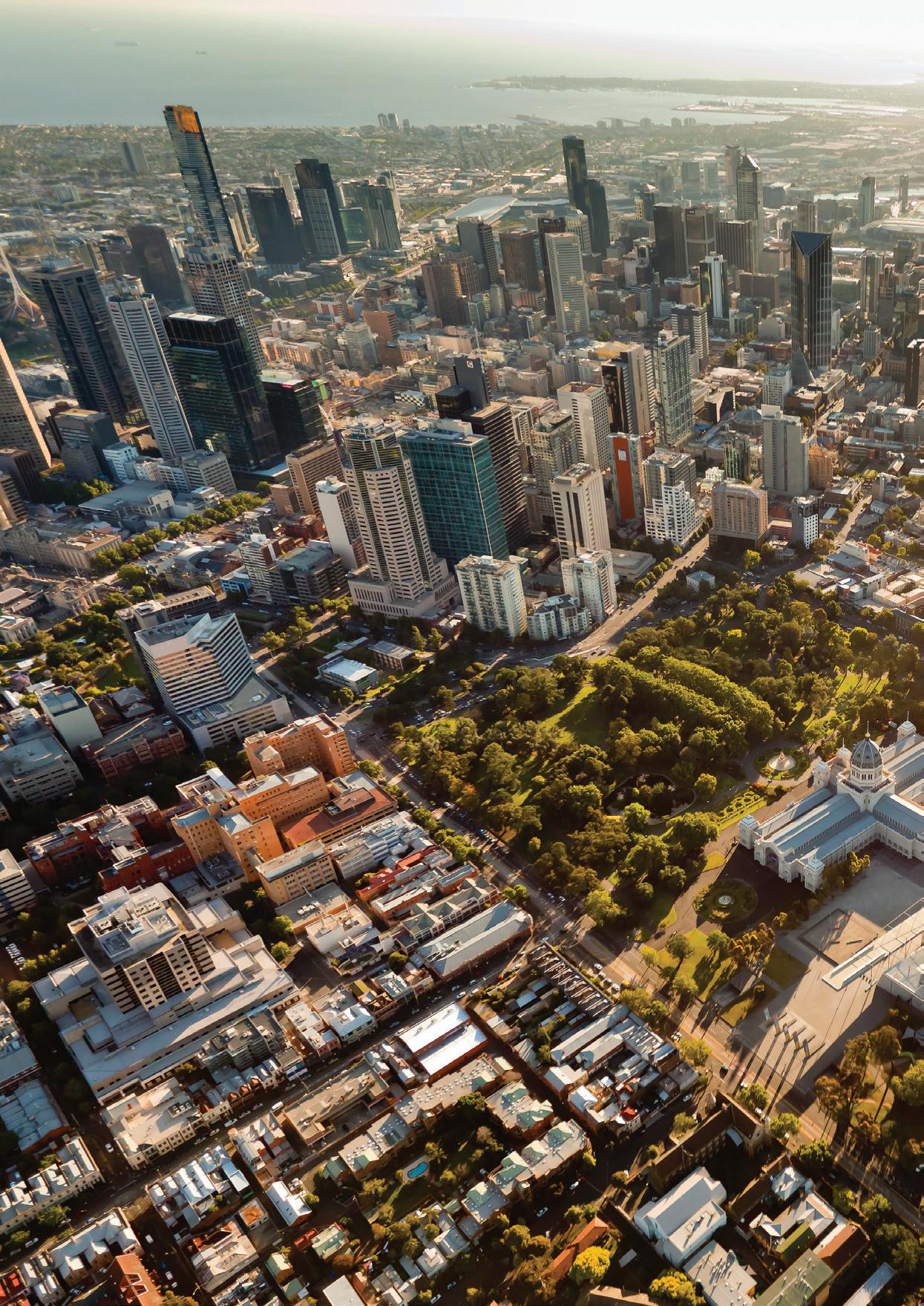
The median weekly rent in Melbourne has risen sharply from $525 in 2023 to $600 in 2024.
No properties in metropolitan Melbourne were affordable for a single person on JobSeeker, Youth Allowance, or the Disability Support Pension.
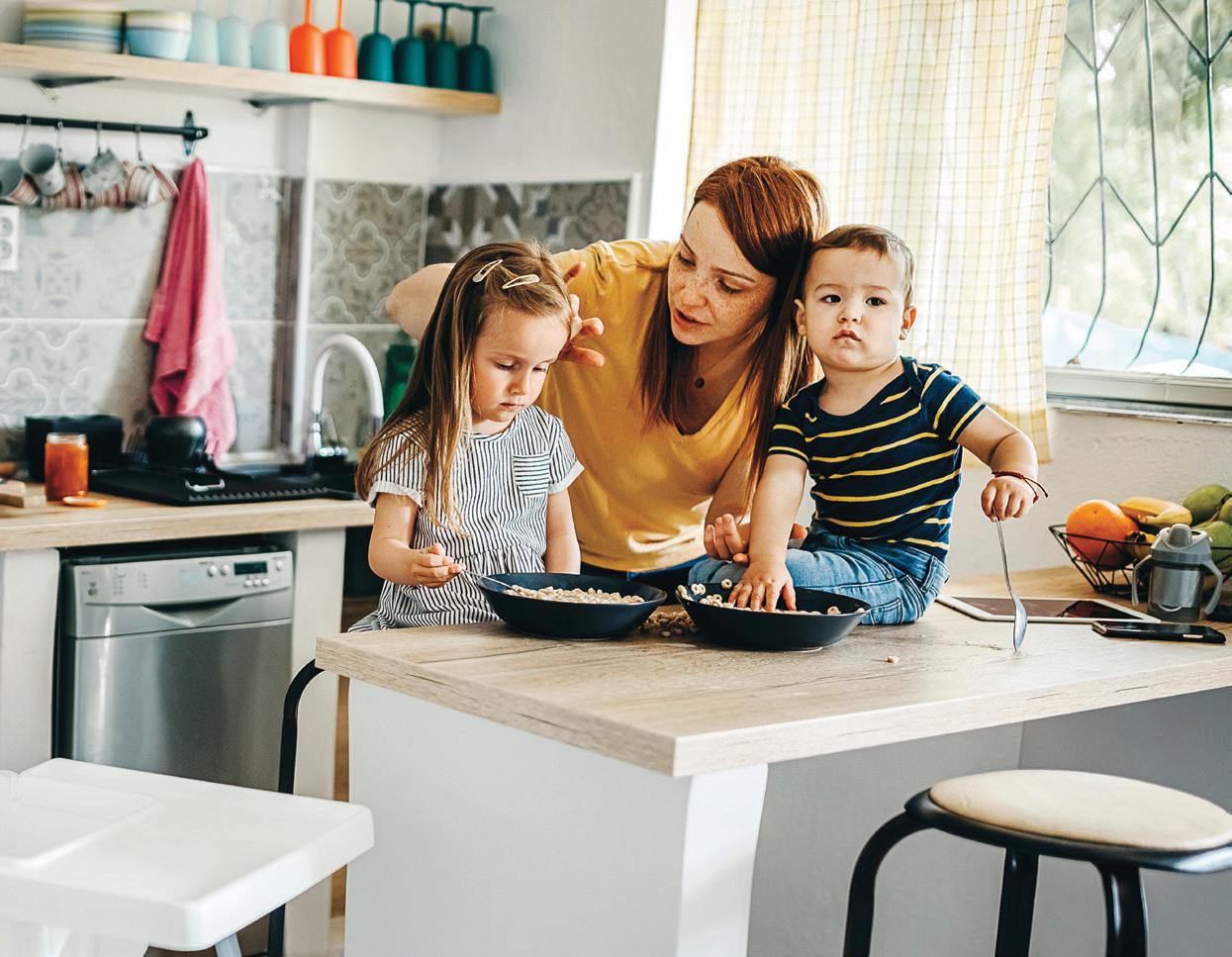
Rental
On the Snapshot weekend of 16 March 2024, across metropolitan Melbourne, these are the number of unique properties affordable and appropriate for:
Couple, two children (one aged less than 5, one aged less than 10)
Single, two children one aged less than 5, one aged less than 10)
Couple, no children
Single, one child (aged less than 5)
Single, one child (aged over 8)
Single
Single, over 21
Single
Single, over 18
Single in share house
Couple, two children (one aged less than 5, one aged less than 10)
Single, two children (one aged less than 5, one aged less than 10
JobSeeker Payment (both adults)
Parenting Payment (Single) Age Pension
Parenting Payment (Single)
JobSeeker Payment
Age Pension
Disability Support Pension
JobSeeker Payment
Youth Allowance
Youth Allowance
Minimum wage + FTB A (both adults)
Minimum wage + FTB A and B + Parenting Payment (Single)
Minimum wage
5,
than 10)
Minimum wage + Parenting Payment (Partnered) + FTB A and B
Table 4. Most affordable LGAs by proportion and number of houses available for households on income support, metropolitan Melbourne
Table 5: Most affordable LGAs by proportion and number of houses available for households on minimum wage, metropolitan Melbourne
Table 6: Ten most affordable LGAs for households on income support in metropolitan Melbourne, based on the number of houses available, in comparison with the 2023 RAS
Number of listings affordable and appropriate to at least one household type receiving income support in 2024
Number of listings in the same LGAs affordable and appropriate to at least one household type receiving income support in 2023
Table 7: Ten most affordable LGAs for households on minimum wage in metropolitan Melbourne, based on the number of houses available, in comparison with the 2023 RAS
Number of listings in the LGAs affordable and appropriate to at least one household type receiving minimum wage in 2024
Number of listings in the same LGAs affordable and appropriate to at least one household type receiving minimum wage in 2023
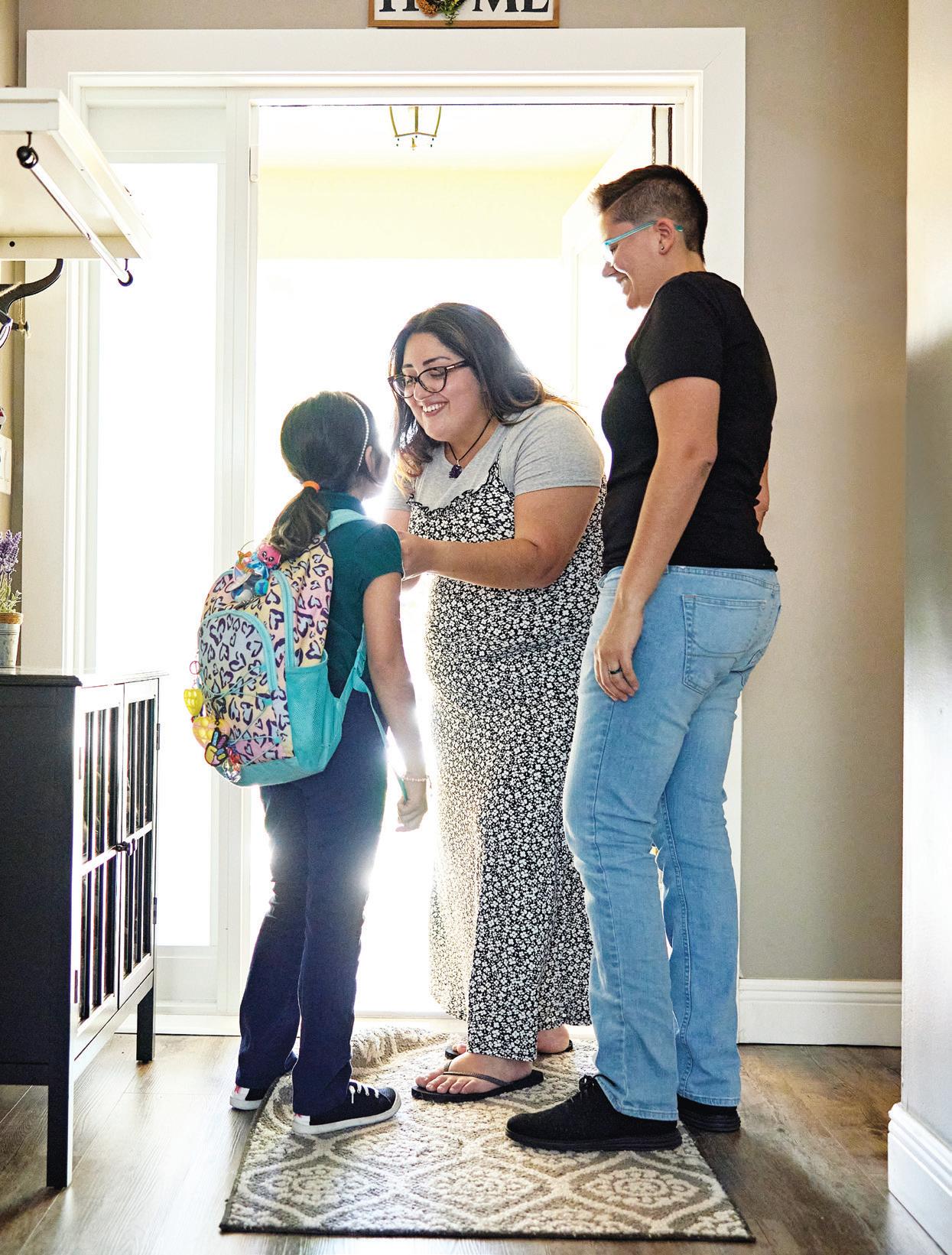
Regional Victoria
In the 48 LGAs across regional Victoria there were 2776 advertised rentals on the day the snapshot was taken. This is an increase from the 1835 properties available in 2023.
Of these listings:
• 148 properties (5.3 per cent) were suitable for at least one household type living on income support payments without placing them in housing stress.
• 1333 properties (48 per cent) were suitable for at least one household type living on minimum wage without placing them in housing stress.
Affordability has improved in the regions – particularly for those on income support
This year’s Snapshot shows a notable increase in affordability for households on income support in regional areas, increasing from 2.29 per cent (42 properties) in 2023 to 5.33 per cent (148 properties) in 2024. There has also been a slight increase in affordability for those earning the minimum wage, up from 943 (51.4 per cent) in 2023 to 1333 (48 per cent) this year.
Regional rentals are still out of reach for the most vulnerable people
On the Snapshot weekend there were no properties advertised for rent that met the criteria to be deemed affordable and appropriate for a single person relying on JobSeeker or Youth Allowance, and just two properties suitable for a single parent receiving JobSeeker.
There was only one property affordable for someone receiving the Disability Support Pension – a twobedroom home in the small town of Nhill, halfway between Melbourne and Adelaide. This was the only property that met these criteria in the entire state. Despite being deemed affordable, in practice this property may not be accessible or suitable for a person living with a disability. Photographs from the online listing show that there is a concrete step up to the front door, and the bathroom is an older style which may cause difficulties for a wheelchair user or someone with limited mobility. The remote location of the town could also make accessing services such as medical specialists and NDIS supports challenging, and poor access to public transport in the area would be inconvenient for someone who does not drive or own a car.
Single people continue to struggle more than couples
As we discussed in the 2023 RAS single people and families with one income face a greater challenge when it comes to securing an appropriate and affordable rental than those who have the benefit of two incomes. 259 properties (9.3 per cent) were affordable for a single parent with two children earning minimum wage, while a family with one parent on minimum wage and the other receiving Parenting Payment (Partnered) could afford 403 properties. A single parent with one child receiving the Parenting Payment (Single) could afford to rent just 5 (0.2 per cent) of the properties advertised during the Snapshot weekend.
The same is true for older Victorians and retirees. Single people receiving the Age Pension could afford 13 (0.5 per cent) of the available properties, while couples who are both receiving this payment would be able to afford 106 (3.8 per cent) of properties.
Listings are scarce in the most affordable regional LGAs
There were just two properties listed for rent in Yarriambiack and West Wimmera, and six in Buloke. So, while 100 per cent of the properties listed for rent on the Snapshot weekend in these areas were deemed affordable for at least one household type receiving income support, the incredibly low number of listings renders this statistic meaningless. Three of the 48 LGAs in regional Victoria did not have any properties listed for rent on the Snapshot weekend.
There are more affordable properties on the market in regional towns
Greater Geelong, Latrobe and Baw Baw were the most affordable LGAs for those receiving income support. In Greater Geelong there were 24 affordable properties compared to just six in 2023, while in Latrobe there were 22, up from 11 last year.
Affordability has improved for those on income support and minimum wage in the regions, particularly in Greater Geelong.
There were just 5 properties (0.3 per cent) that were suitable for a single parent with one child receiving the Parenting Payment.
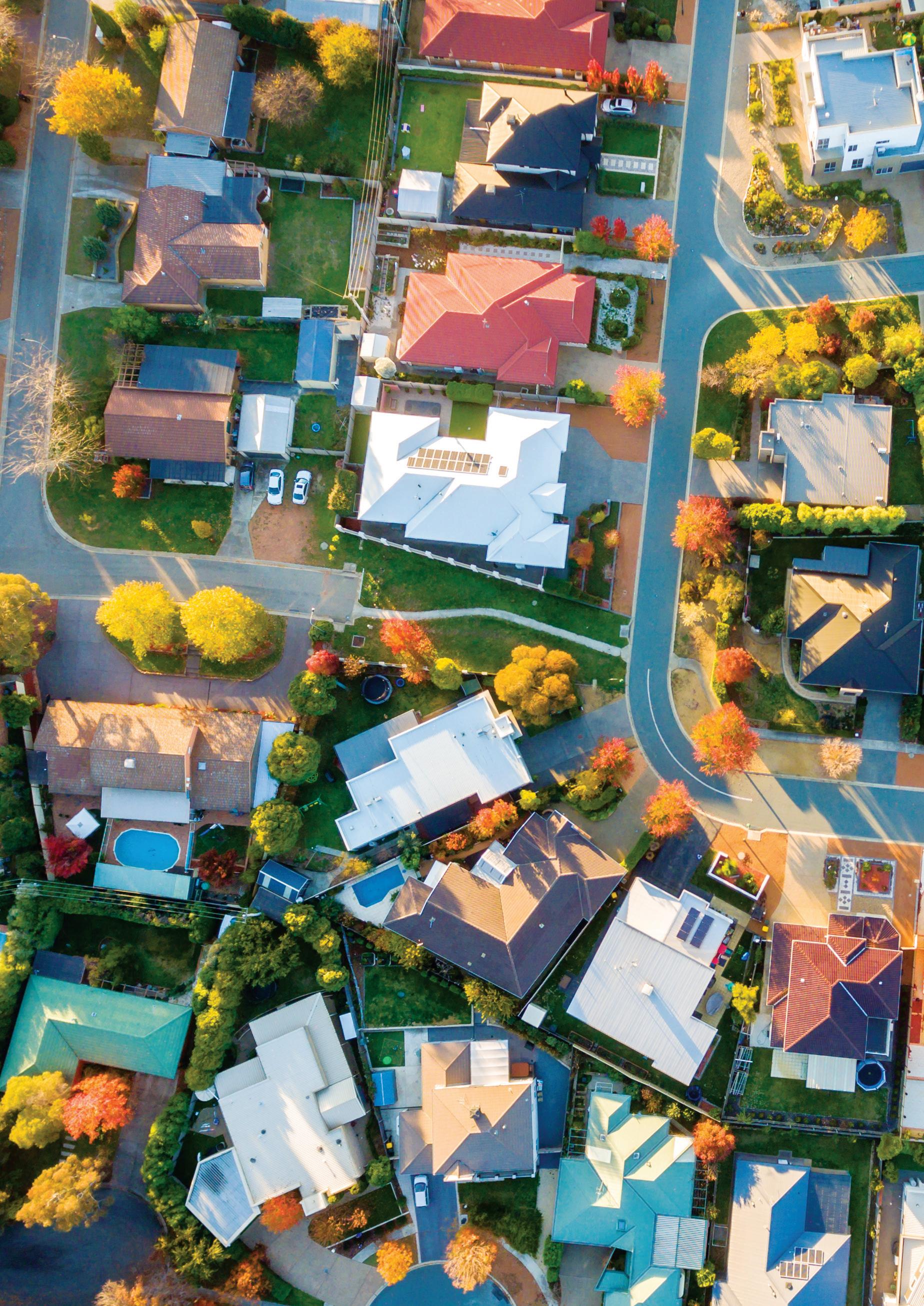
A property in the town of Nhill was the only listing in the entire state deemed affordable and appropriate for a person on the Disability Support Pension.
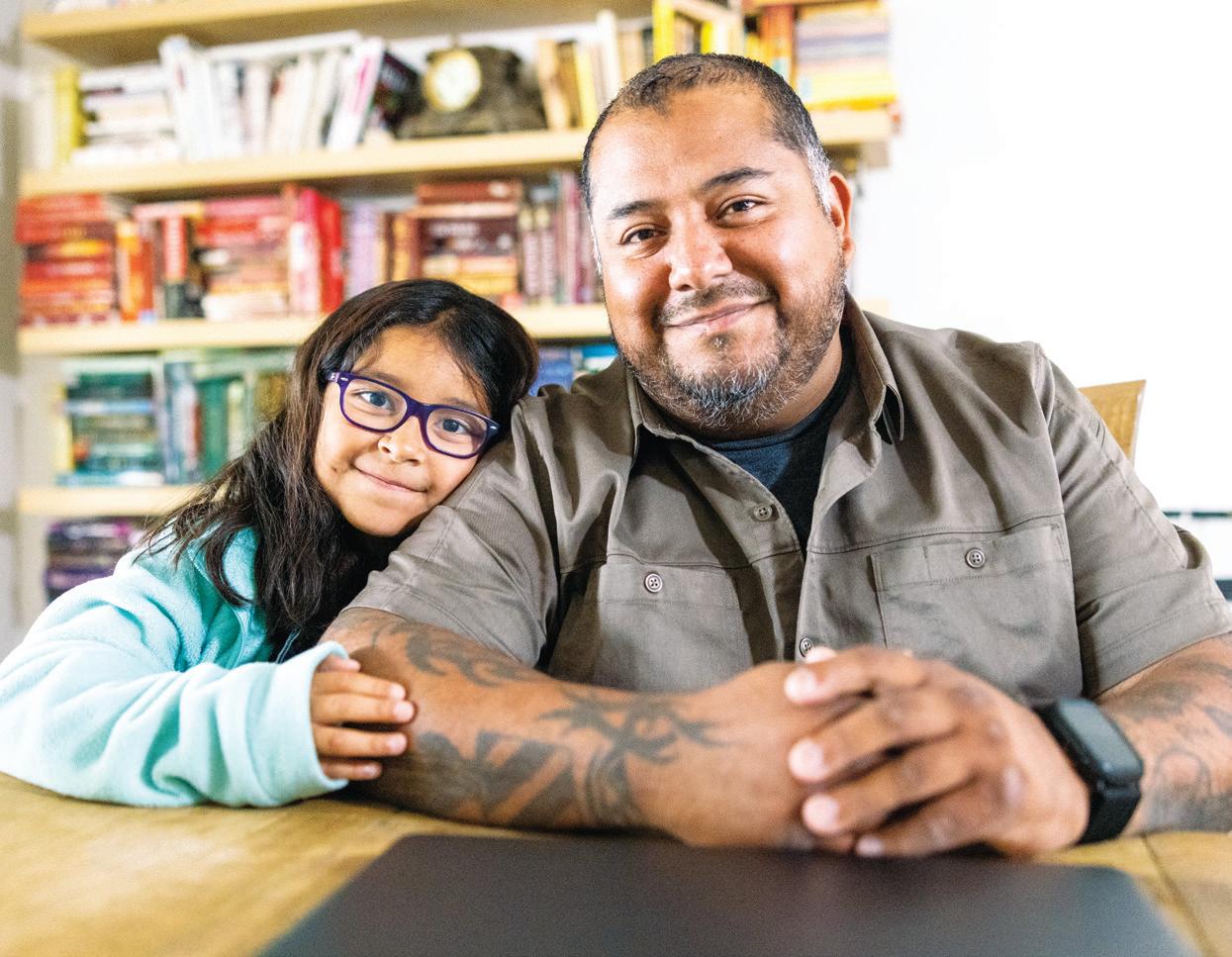
Rental Affordability, regional Victoria
On the Snapshot weekend off 16 March 2024, across regional Victoria, these are the number of unique properties affordable and appropriate for:
Household Type
Couple, two children (one aged less than 5, one aged less than 10)
Single, two children (one aged less than 5, one aged less than 10)
Couple, no children
Single, one child (aged less than 5)
Single, one child (aged over 8)
Single
Single, over 21
Single
Single, over 18
Single in share house
Couple, two children (one aged less than 5, one aged less than 10) Single, two children (one aged less than 5,
aged less than 10)
Parenting Payment (Single)
10)
Parenting Payment (Single)
JobSeeker Payment Age Pension
Support Pension
JobSeeker Payment
Youth Allowance Youth Allowance
wage + FTB A (both adults) Minimum wage + FTB A and B + Parenting Payment (Single)
wage + Parenting Payment (Partnered) + FTB A and B
Table 9: Most affordable LGAs by proportion and number of houses available for households on income support, regional Victoria
Table 10: Most affordable LGAs by proportion and number of houses available for households on minimum
Table 11: Ten most affordable LGAs for households on income support in regional Victoria, based on the number of houses available, in comparison with the 2023 RAS
Number of listings affordable and appropriate to at least one household type receiving income support in 2024
Number of listings in the same LGAs affordable and appropriate to at least one household type receiving income support in 2023
Table 12: Ten most affordable LGAs for households on minimum wage in regional Victoria, based on the number of houses available, in comparison with the 2023 RAS
Number of listings affordable and appropriate to at least one household type receiving minimum wage in 2024
Number of listings in the same LGAs affordable and appropriate to at least one household type receiving minimum wage in 2023

Policy Solutions
Australia needs a national strategy to end youth homelessness, particularly for those who have spent time in the out-of-home care system
Young people aged 12 to 25 make up around a quarter of homeless people in Australia, but only 2.9 per cent of social housing is leased to people under 24. In 2022/23 almost 16,000 young people attended Victorian homelessness services looking for help. We need a dedicated housing strategy aimed at addressed and preventing youth homelessness, with a focus on the unique needs and risks faced by young people who are homeless, particularly those who have spent time in out-of-home care (OoHC).
Housing is a key determinant of health, contributing to a person’s identity, safety, social support, and sense of control over their own life. Many young people in care have experienced significant trauma and leave care without an ongoing support system in place, making them particularly vulnerable to the negative impacts of homelessness or insecure housing. The Keep Caring Report found that a third of young care leavers in Victoria are homeless within three years, and 70 per cent live below the poverty line. Half require acute mental health services, 44 per cent are disengaged from education and/or training and one quarter have contact with the criminal justice system. Of those leaving care in 2019, 22 per cent identified as Aboriginal and one third live with a disability. The report advocated for reform of the out-of-home care system to better support young people and critically to develop independent living skills for their future wellbeing.
Successful programs designed to help these young people transition from OoHC to independent living, such as Anglicare Victoria’s Village 21 and Kids Under Cover’s studio model, should be scaled to support more young people leaving care. Doing so would align with the Home Stretch reforms adopted recently by all states in Australia, by building the skills and capabilities of young people before they exit care, enabling the young person and their care team to find a leaving care pathway that is right for them, and more readily access the supports required to move into independent living.
Anglicare Victoria supports the Council to Homeless Persons’ call for the Victorian Government to invest $136.8 million over the next four years in a dedicated youth housing model, as well as 5000 new social housing properties and additional supports for young people with mental illness.
Both state and federal governments must invest in more social and affordable housing
There is a critical lack of social and affordable homes for low-income Victorians who cannot afford to rent a property on the private market. Greater collaboration between state and federal governments is required to build more affordable homes for these people, particularly as rising house prices and a growing population put further pressure on an undersupplied rental market. Victorians on income support or minimum wage shouldn’t have to compete with high income earners for private rental properties.
According to the Australian Housing and Urban Research Institute, we are facing a national shortfall in the tens of thousands when it comes to social and affordable rentals. This figure is projected to grow to about 166,000 homes by 2036. The Victorian Government’s $5.3 billion Big Housing Build includes some innovative solutions, such as a Ground Lease model which will allow older public housing dwellings to be redeveloped into more modern and energy efficient homes that better suit the needs of Victorians, including those with disability. While the Big Housing Build will deliver 12,000 new social and affordable housing units over the next four years, it falls well short of the number of new properties that are required. An additional 6000 homes delivered by the Commonwealth’s Housing Australia Future Fund is also welcome, but this is still not enough.
With more than 100,000 people on the social housing waiting list in Victoria, these projects do not come close to addressing the pressing need in our community. VCOSS estimates that the Victorian Government will need to build more than 60,000 homes over the next decade. As low-income Victorians continue to be priced out of the private rental market, we must invest in more social housing for our most vulnerable renters.
Income support payments must be increased substantially to lift vulnerable Australians out of poverty
The low rates of Commonwealth support payments mean people are trapped in poverty and housing stress. As the cost of living continues to rise, people relying on payments such as JobSeeker, Youth Allowance and the Parenting Payment are unable to keep up and are forced to make impossible choices to keep a roof over their heads. These payments simply aren’t enough to cover basic living costs such as food, medication, and utilities. Despite a $20 per week increase in last year’s budget, JobSeeker is still one of the lowest income support payments provided by a government in a wealthy country.
Anglicare Australia’s 2024 Back to Basics report discusses the disproportionate impact of high inflation on those with lower incomes. The report reveals that, in addition to rising rents, everyday costs have skyrocketed. Housing costs are up by 22 per cent, electricity by 17 per cent, food, and groceries by 17 per cent, and transport by 11 per cent. At the same time, most Centrelink payments are only raised in line with the CPI, leaving low-income Australians robbing Peter to pay Paul. People on lower incomes are already operating on a shoestring budget, many without savings to fall back on in tough times.
Anglicare Victoria welcomes the Albanese Government’s decision to expand access to the Parenting Payment (Single) to more people in the 2023-24 Federal Budget. Single parents, most of whom are women, are now able to receive this payment until their youngest child turns 14. Previously they were forced onto JobSeeker, a lower payment with strict conditions and onerous mutual obligation requirements, when their youngest child turned eight. However, improving accessibility to one payment is not enough. Recent research by ACOSS found that three quarters of people receiving JobSeeker skipped meals and six in ten could not afford medical care. A substantial increase to all Commonwealth support payments is urgently needed to ensure these people are not trapped in poverty.
Commonwealth Rent Assistance must be urgently reformed to reflect current median rents
This payment was designed as an additional support to help people on low incomes pay their rent, but it has failed to keep pace with the booming rental market. In 2020 the median weekly rent in metropolitan Melbourne was $450, and $350 in regional Victoria. Commonwealth Rent Assistance payments at the time were $139.60 for singles and $131.60 for couples, with these rates increasing slightly for parents depending on the number of children they have. Singles paying the median rent would have had a gap of $310.40 in Melbourne and $210.40 in the regions.
In 2024, median weekly rents are $600 in metropolitan Melbourne and $460 in regional Victoria, yet the maximum amount of Commonwealth Rent Assistance is still only $177.20 for couples and $188.20 for singles (with no children). Today a single person paying the median rent would have a shortfall of $411.80 in metro areas and $271.80 in regional Victoria. Over the past four years renters in Victoria have become increasingly worse off, and those living in metro Melbourne can now expect to pay over $100 more per week on top of their Commonwealth Rent Assistance for the same property compared to 2020.
It's no surprise that 48 per cent of low-income rental households in Victoria are in housing stress and are struggling to afford other essentials. Continuing to index this payment twice a year to the rate of CPI, like all Commonwealth assistance payments, is not enough. Rents have risen faster than inflation since 2000, and this trend is likely to continue given how undersupplied the market is. Urgent reform is needed to increase Commonwealth Rent Assistance so that it reflects current median rental prices. Doing so would allow those in housing stress to spend more of their money on food, education, and transport and give them a chance to live a happier, healthier life.
We need a national plan that tackles the root causes of homelessness for vulnerable groups
More investment is needed in services to address social issues such as family violence, substance abuse, mental health, and disability, which can push people into financial stress and homelessness.
Family violence is increasing in Victoria, with Safe and Equal reporting that Victoria Police attend a family violence incident every six minutes. Women, particularly women with a disability and those who identify as Aboriginal, are most affected. Aboriginal women are 33 times more likely to be hospitalised due to family violence, and women with a disability are 40 per cent more likely to experience family violence. According to FaHCSIA, family violence is the main reason women and children are forced to leave their homes. More investment is needed to prevent family violence and provide women and children who flee violent homes with a safe place to heal and rebuild their lives.
Women over 65 are the fastest-growing cohort of homeless people in Australia. This is often because these women have taken time away from paid work to care for children or worked in casual and part-time roles while juggling family responsibilities. As a result, they have accumulated less wealth than men of the same age, including less superannuation. When faced with family violence or a relationship breakdown, these women don’t have the savings needed to secure housing in the private market. More needs to be done to ensure that these women enjoy a comfortable and affordable home in their retirement.
About Anglicare Victoria
Anglicare Victoria provides a range of services for children, youth, and families across Victoria. These include:
Out-of-home care services for children and young people, and post-care support
• Family support services, including family counselling, case management, and parenting education
Education programs for children and young people
• Emergency relief and financial counselling services
• Disability support services and respite
• Services for alcohol and drugs, mental health, and problem gambling support
• Refugee and asylum seeker services
• Mentoring and volunteer programs www.anglicarevic.org.au
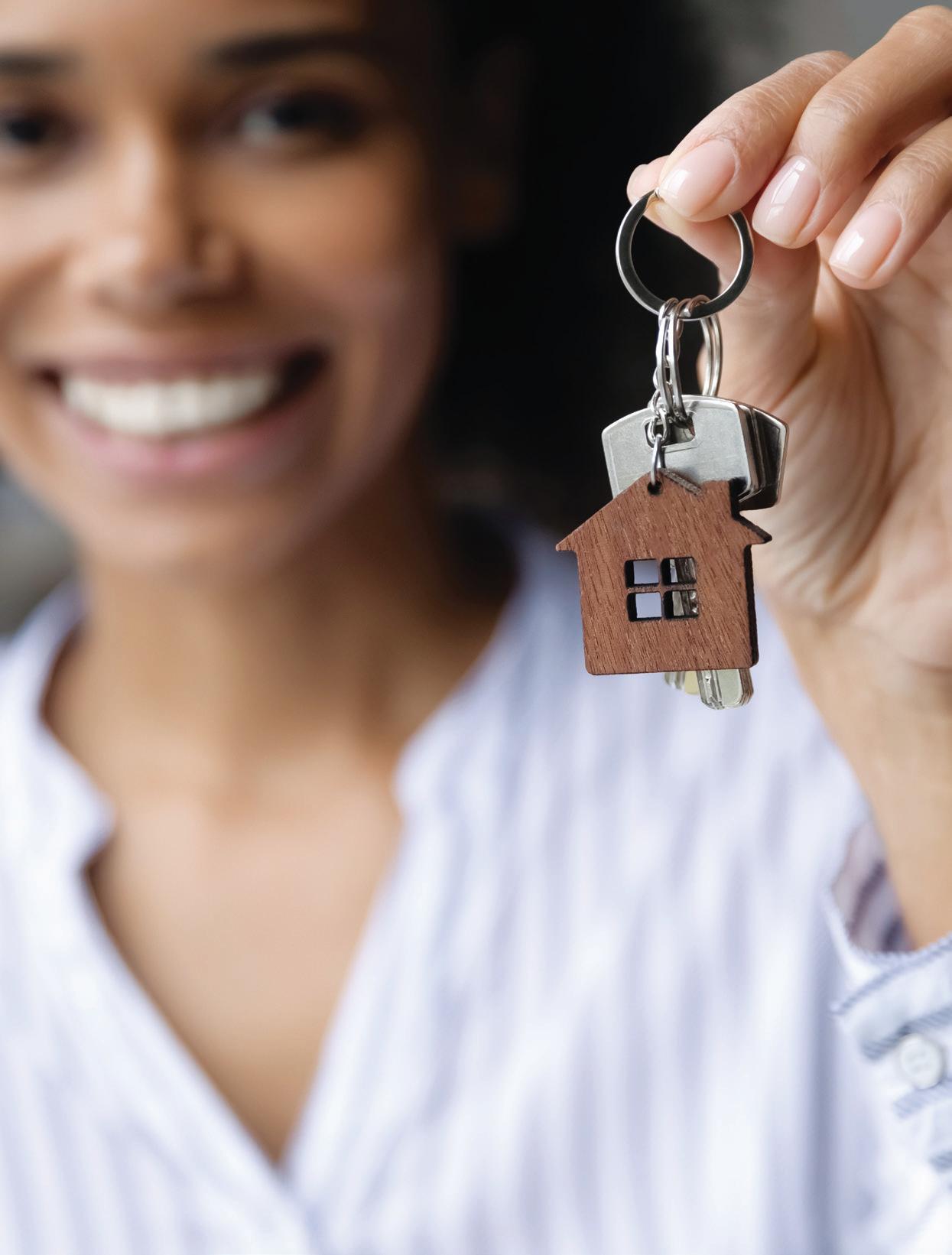
Data and Methodology
Anglicare Victoria’s 2024 Rental Affordability Snapshot (RAS) was conducted as part of the national Snapshot undertaken by Anglicare Australia. It covered 80 local government areas (LGAs) in metropolitan Melbourne and Victorian rural, regional, and coastal areas – 32 from metropolitan areas and 48 in regional Victoria.
On Saturday, 16 March 2024, realestate.com.au provided a data dump of all rental listings for the Victorian RAS. The data was cleaned to remove duplicates, conditional accommodation, serviced apartments, properties listed as ‘rent to buy’ and commercial properties – including car spaces, warehouses, office spaces and sheds.
The suitability of listed properties was assessed against the different categories of various low-income households. A dwelling was deemed suitable if it was both affordable and appropriate for a low-income household. Household groups were made up of single people or family groups living on Commonwealth income support and/or minimum wage. Single parents earning the minimum wage may also be eligible for the Parenting Payment (Single). From 2024, the Snapshot includes Parenting Payment (Single) in our calculations.
How was affordability defined?
Renting was affordable if it cost less than 30 per cent of a household’s total income (above 30 per cent is commonly considered to indicate housing stress for low-income households). We included Commonwealth Rent Assistance (CRA) as income.
How was appropriateness defined?
Appropriateness refers to rentals containing enough bedrooms for each household type. Specifically:
• a share house room or bedsit was suitable for most single people, including age pensioners – but not a couple or a disability support pensioner.
a one to two-bedroom property was suitable for a single person or couple.
• a two to three-bedroom property was suitable for parents with a small number of children.
A property can be affordable and appropriate for more than one household type. For example, a bedsit or a three-bedroom home are both suitable for a single person to rent.
Free and confidential assistance is available
We’re here for you
Call Anglicare Victoria on 1800 809 722 to chat to a financial counsellor
Or visit www.anglicarevic.org.au/our-services/financial-counselling to find out more.
Additional support services
National Debt Helpline – 1800 007 007
Lifeline Australia – 13 11 14
Parentline – 13 22 89
Kids Helpline – 1800 55 1800
MensLine Australia – 1300 78 99 78
1800RESPECT – 1800 737 732
Safe Steps Family Violence – 1800 015 188
Carers Australia – 1800 242 636
CENTRAL OFFICE
103 Hoddle Street, Collingwood VIC 3066
PO Box 45, Abbotsford VIC 3067 P. 1800 809 722 E. Info@anglicarevic.org.au


